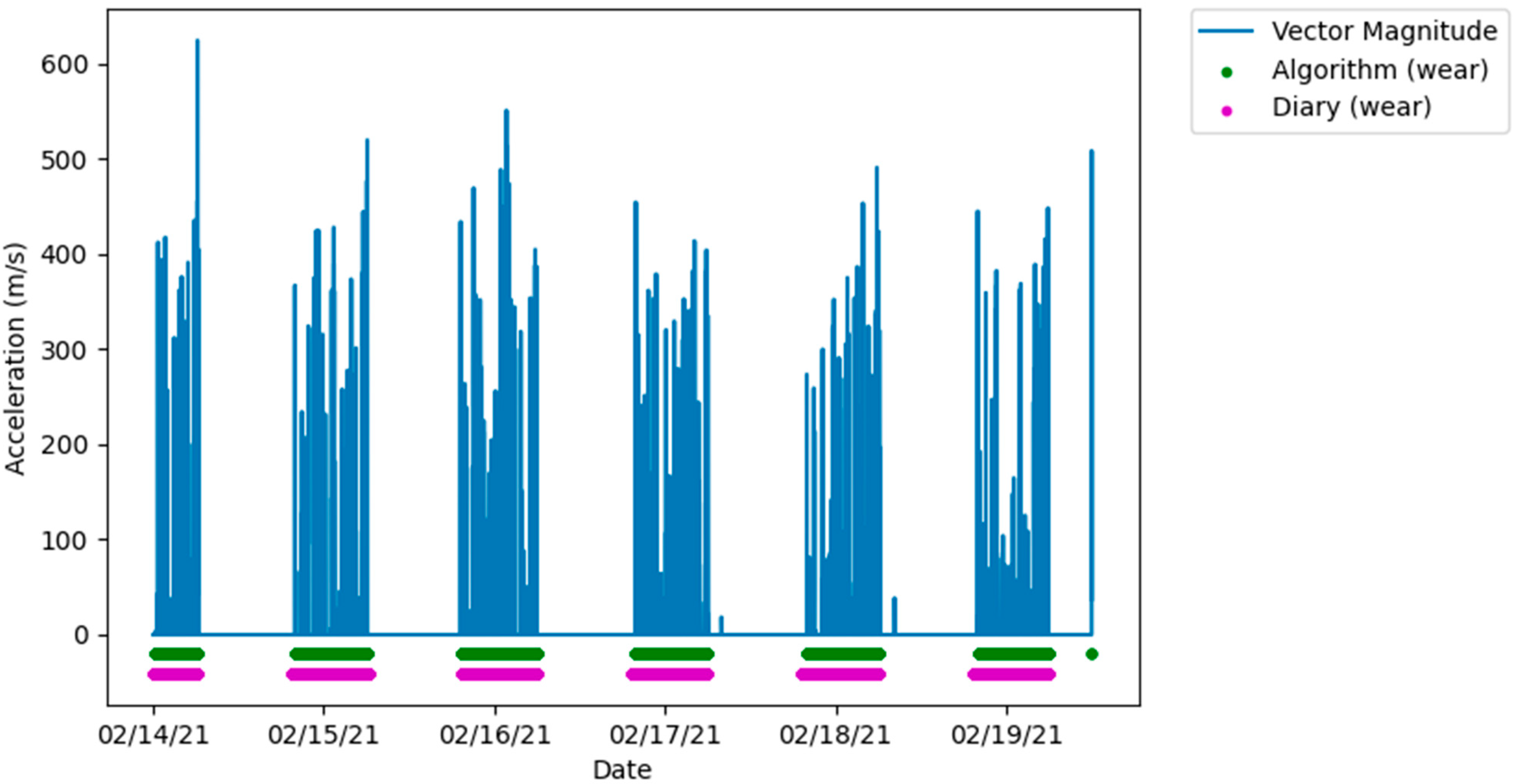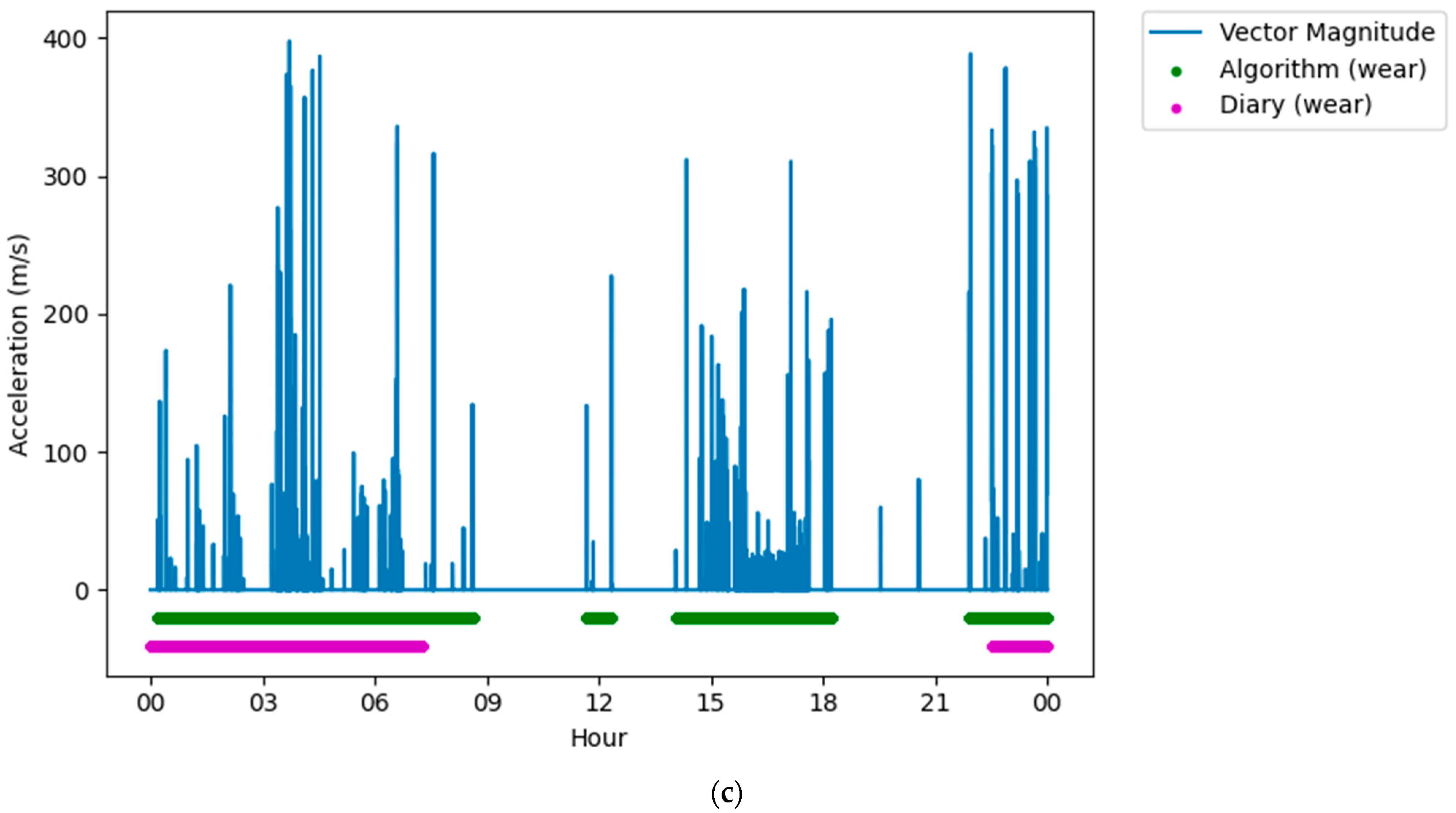Measuring Foot Abduction Brace Wear Time Using a Single 3-Axis Accelerometer †
Abstract
:1. Introduction
2. Materials and Methods
2.1. Data Collection
2.2. Statistical Analysis
3. Results
4. Discussion
5. Conclusions
Supplementary Materials
Author Contributions
Funding
Institutional Review Board Statement
Informed Consent Statement
Data Availability Statement
Conflicts of Interest
References
- Radler, C. The Ponseti method for the treatment of congenital club foot: Review of the current literature and treatment recommendations. Int. Orthop. 2013, 37, 1747–1753. [Google Scholar] [CrossRef] [PubMed] [Green Version]
- Dietz, F.R.; Noonan, K. Treatment of clubfoot using the ponseti method. JBJS Essent. Surg. Tech. 2016, 6, e28. [Google Scholar] [CrossRef]
- Zionts, L.E.; Dietz, F.R. Bracing following correction of idiopathic clubfoot using the ponseti method. J. Am. Acad. Orthop. Surg. 2010, 18, 486–493. [Google Scholar] [CrossRef]
- Chand, S.; Mehtani, A.; Sud, A.; Prakash, J.; Sinha, A.; Agnihotri, A. Relapse following use of Ponseti method in idiopathic clubfoot. J. Child. Orthop. 2018, 12, 566–574. [Google Scholar] [CrossRef]
- Cosma, D.; Vasilescu, D.; Văleanu, M. The importance of foot abduction brace after the Ponseti treatment of clubfoot. Balneo Res. J. 2018, 9, 382–384. [Google Scholar] [CrossRef]
- Nogueira, M.P.; Fox, M.; Miller, K.; Morcuende, J. The Ponseti method of treatment for clubfoot in Brazil: Barriers to bracing compliance. Iowa Orthop. J. 2013, 33, 161–166. [Google Scholar]
- Goksan, S.B.; Bilgili, F.; Eren, I.; Bursali, A.; Koc, E. Factors affecting adherence with foot abduction orthosis following Ponseti method. Acta Orthop. Traumatol. Turc. 2015, 49, 620–626. [Google Scholar] [CrossRef]
- Aguilar-Farías, N.; Brown, W.J.; Olds, T.; Peeters, G. (Geeske) Validity of self-report methods for measuring sedentary behaviour in older adults. J. Sci. Med. Sport 2015, 18, 662–666. [Google Scholar] [CrossRef]
- Barone Gibbs, B.; Paley, J.L.; Jones, M.A.; Whitaker, K.M.; Connolly, C.P.; Catov, J.M. Validity of self-reported and objectively measured sedentary behavior in pregnancy. BMC Pregnancy Childbirth 2020, 20, 99. [Google Scholar] [CrossRef]
- Fiedler, J.; Eckert, T.; Burchartz, A.; Woll, A.; Wunsch, K. Comparison of self-reported and device-based measured physical activity using measures of stability, reliability, and validity in adults and children. Sensors 2021, 21, 2672. [Google Scholar] [CrossRef]
- Morgenstein, A.; Davis, R.; Talwalkar, V.; Iwinski, H.; Walker, J.; Milbrandt, T.A. A Randomized clinical trial comparing reported and measured wear rates in clubfoot bracing using a novel pressure sensor. J. Pediatr. Orthop. 2015, 35, 185–191. [Google Scholar] [CrossRef] [PubMed]
- Funk, J.F.; Lebek, S. Clubfoot therapy in accordance with ponseti-current standard. Z. Orthop. Unf. 2019, 157, 411–416. [Google Scholar]
- Richards, B.S.; Faulks, S.; Felton, K. Objective measurement of brace wear in successfully ponseti-treated clubfeet: Pattern of decreasing use in the first 2 years. J. Am. Acad. Orthop. Surg. 2020, 28, 383–387. [Google Scholar] [CrossRef] [PubMed]
- Sangiorgio, S.N.; Ho, N.C.; Morgan, R.D.; Ebramzadeh, E.; Zionts, L.E. The objective measurement of brace-use adherence in the treatment of idiopathic clubfoot. J. Bone Jt. Surg. 2016, 98, 1598–1605. [Google Scholar] [CrossRef] [PubMed] [Green Version]
- Aroojis, A.; Pandey, T.; Dusa, A.; Krishnan, A.G.; Ghyar, R.; Ravi, B. Development of a functional prototype of a SMART (Sensor-integrated for Monitoring and Remote Tracking) foot abduction brace for clubfoot treatment: A pre-clinical evaluation. Int. Orthop. 2021, 45, 2401–2410. [Google Scholar] [CrossRef] [PubMed]
- Aadland, E.; Andersen, L.B.; Anderssen, S.A.; Resaland, G.K. A comparison of 10 accelerometer non-wear time criteria and logbooks in children. BMC Public Health 2018, 18, 323. [Google Scholar] [CrossRef]
- Chadwell, A.; Kenney, L.; Granat, M.H.; Thies, S.; Head, J.; Galpin, A.; Baker, R.; Kulkarni, J. Upper limb activity in myoelectric prosthesis users is biased towards the intact limb and appears unrelated to goal-directed task performance. Sci. Rep. 2018, 8, 11084. [Google Scholar] [CrossRef]
- Vanhelst, J.; Vidal, F.; Drumez, E.; Béghin, L.; Baudelet, J.-B.; Coopman, S.; Gottrand, F. Comparison and validation of accelerometer wear time and non-wear time algorithms for assessing physical activity levels in children and adolescents. BMC Med. Res. Methodol. 2019, 19, 72. [Google Scholar] [CrossRef]
- Silver, G.; Granat, L. Comparing an objective measure of foot abduction brace non-wear time with self-reported measures-the 8th international conference on ambulatory monitoring of physical activity and movement. J. Meas. Phys. Behav. 2021, 4, S1–S85. [Google Scholar]
- Brønd, J.C.; Andersen, L.B.; Arvidsson, D. Generating ActiGraph Counts from Raw Acceleration Recorded by an Alternative Monitor. Med. Sci. Sports Exerc. 2017, 49, 2351–2360. [Google Scholar] [CrossRef] [PubMed]
- McHugh, M.L. Interrater reliability: The kappa statistic. Biochem. Med. 2012, 22, 276–282. [Google Scholar] [CrossRef]
- Alves, C. Bracing in clubfoot: Do we know enough? J. Child. Orthop. 2019, 13, 258–264. [Google Scholar] [CrossRef] [PubMed]
- Ramirez, N.; Flynn, J.M.; Fernández, S.; Seda, W.; Macchiavelli, R.E. Orthosis noncompliance after the ponseti method for the treatment of idiopathic clubfeet: A relevant problem that needs reevaluation. J. Pediatr. Orthop. 2011, 31, 710–715. [Google Scholar] [CrossRef]
- Feinstein, A.R. On white-coat effects and the electronic monitoring of compliance. Arch. Int. Med. 1990, 150, 1377–1378. [Google Scholar] [CrossRef]
- Fletcher, B.R.; Hartmann-Boyce, J.; Hinton, L.; McManus, R.J. The Effect of self-monitoring of blood pressure on medication adherence and lifestyle factors: A systematic review and meta-analysis. Am. J. Hypertens. 2015, 28, 1209–1221. [Google Scholar] [CrossRef] [PubMed] [Green Version]





Publisher’s Note: MDPI stays neutral with regard to jurisdictional claims in published maps and institutional affiliations. |
© 2022 by the authors. Licensee MDPI, Basel, Switzerland. This article is an open access article distributed under the terms and conditions of the Creative Commons Attribution (CC BY) license (https://creativecommons.org/licenses/by/4.0/).
Share and Cite
Griffiths, B.; Silver, N.; Granat, M.H.; Lebel, E. Measuring Foot Abduction Brace Wear Time Using a Single 3-Axis Accelerometer. Sensors 2022, 22, 2433. https://doi.org/10.3390/s22072433
Griffiths B, Silver N, Granat MH, Lebel E. Measuring Foot Abduction Brace Wear Time Using a Single 3-Axis Accelerometer. Sensors. 2022; 22(7):2433. https://doi.org/10.3390/s22072433
Chicago/Turabian StyleGriffiths, Benjamin, Natan Silver, Malcolm H. Granat, and Ehud Lebel. 2022. "Measuring Foot Abduction Brace Wear Time Using a Single 3-Axis Accelerometer" Sensors 22, no. 7: 2433. https://doi.org/10.3390/s22072433
APA StyleGriffiths, B., Silver, N., Granat, M. H., & Lebel, E. (2022). Measuring Foot Abduction Brace Wear Time Using a Single 3-Axis Accelerometer. Sensors, 22(7), 2433. https://doi.org/10.3390/s22072433





